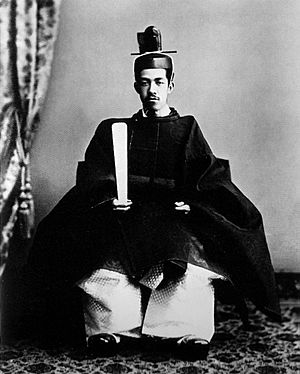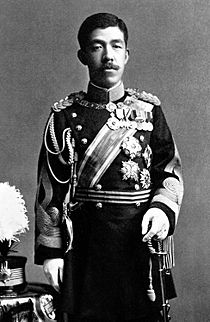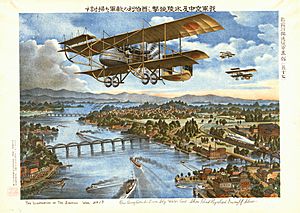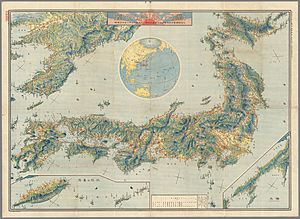Taishō era facts for kids
大正
| 30 July 1912 – 25 December 1926 | |

Emperor Taishō (1900)
|
|
| Preceded by | Meiji |
|---|---|
| Including | |
| Followed by | Shōwa |
| Monarch | Taishō |
 |
|---|
|
The Taishō era (大正 (Taishō), [taiɕoː dʑidai]) was a time in Japan's history. It lasted from July 30, 1912, to December 25, 1926. This period happened during the rule of Emperor Taishō. Because the new emperor was often sick, political power started to shift. It moved away from the old group of powerful elder statesmen, called genrō. Instead, power began to move towards Japan's parliament, known as the Imperial Diet, and democratic political parties. This is why the Taishō era is often seen as a time of growing democracy in Japan, known as Taishō Democracy. It was different from the more chaotic Meiji era before it and the military-focused early part of the Shōwa era that followed.
Contents
What Does "Taishō" Mean?
The two Japanese characters for Taishō (大正) come from an old Chinese book called the I Ching. The phrase they come from means "Great prevalence is achieved through rectitude, and this is the Dao of Heaven." So, the name Taishō can be understood to mean "great rectitude" or "great righteousness."
Japan After the Meiji Era

On July 30, 1912, Emperor Meiji passed away. His son, Crown Prince Yoshihito, became the new Emperor of Japan. In his first speech as emperor, he announced the name for his reign, which was Taishō.
The end of the Meiji period saw Japan investing a lot of money. This included projects at home and abroad, as well as defense programs. The country's money was almost used up, and it didn't have enough foreign money to pay its debts. Western culture, which had become popular in the Meiji period, continued to influence Japan. Artists like Kobayashi Kiyochika started using Western painting styles. Others, like Okakura Kakuzō, kept their interest in traditional Japanese painting. Writers like Mori Ōgai studied in the West. They brought back new ideas about life that were shaped by Western thinking.
After the Meiji Restoration in 1868, Japan achieved many goals. It grew economically and politically without becoming a colony like other Asian nations. This time also brought new ideas. People around the world were interested in communism and socialism. A new group of city workers, called the proletariat, was growing. Early movements for change wanted things like all men being able to vote, help for people in need, and rights for workers. However, the government often stopped these activities. This led to more extreme actions from some groups and even more government control. For example, the Japan Socialist Party was shut down just one year after it started in 1906.
The Taishō period began with a political problem in 1912–13. This problem stopped the way politics had been working before. When Prime Minister Saionji Kinmochi tried to cut the military budget, the army minister quit. This caused the whole government cabinet to fall apart. Both Yamagata Aritomo and Saionji refused to take office again. The genrō (elder statesmen) couldn't find a solution. People were angry that the military was controlling the government. They were also upset when Katsura Tarō was asked to be prime minister for a third time. This led to more demands for the genrō to stop controlling politics. In 1913, a new conservative party, the Rikken Dōshikai, was formed. This party won more seats than the Seiyūkai party in late 1914.
On February 12, 1913, Yamamoto Gonnohyōe became prime minister after Katsura. Then, in April 1914, Ōkuma Shigenobu took over from Yamamoto. Crown Prince Yoshihito had married Sadako Kujō on May 10, 1900. Their official coronation ceremony happened on November 11, 1915.
World War I and Japan's Power in China

World War I allowed Japan to become more powerful in Asia. Japan joined the winning side, the Allied Powers. On August 23, 1914, Japan declared war on Germany. Japan quickly took over German-controlled areas in China's Shandong province. They also took German islands in the north Pacific Ocean, including the Marianas, Carolines, and Marshalls. On November 7, the German base at Jiaozhou in China surrendered to Japan.
While its Western allies were busy fighting in Europe, Japan tried to gain more control in China. In January 1915, Japan presented the Twenty-One Demands to the Chinese government. Besides taking over German areas, Japan wanted to control mines and factories in central China. They also wanted China to promise not to give or lease any coastal areas to other countries. Japan also asked for other political, economic, and military controls. If all these demands were met, China would have become like a Japanese protectorate. However, negotiations with China were slow. There was strong anti-Japanese sentiment in China and other countries criticized Japan. This forced Japan to drop some of its demands. Treaties were signed in May 1915.
Japan's power in northern China and other parts of Asia grew through other international agreements. In 1916, an agreement with Russia helped Japan secure its influence in Manchuria and Inner Mongolia. In 1917, agreements with France, Britain, and the United States recognized Japan's gains in China and the north Pacific. The Nishihara Loans (named after Nishihara Kamezo, Japan's representative in Beijing) in 1917 and 1918 helped the Chinese government. But they also put China deeper in debt to Japan. Towards the end of the war, Japan started making more war materials for its European allies. This helped Japan's industries grow and increased its exports. For the first time, Japan became a country that lent money to others, instead of borrowing.
Japan's power in Asia increased after the Russian government collapsed in 1917 due to the Russian Revolution. Japan's army wanted to take advantage of this and planned to occupy Siberia. To do this, Japan needed China's permission to move troops through Chinese land. The number of Japanese troops was reduced so as not to upset the United States. Still, more than 70,000 Japanese soldiers joined a smaller group of Allied forces sent to Siberia in July 1918. This was part of the Allied intervention in the Russian Civil War.
On October 9, 1916, Terauchi Masatake became prime minister, taking over from Ōkuma Shigenobu. On November 2, 1917, the Lansing–Ishii Agreement was signed. This agreement recognized Japan's interests in China. It also promised to keep an "Open Door Policy" for trade in China. From July to September 1918, there were rice riots in Japan. These happened because the price of rice was going up. The widespread riots and breakdown of public order led to the end of Terauchi Masatake's government.
Japan After World War I: Taishō Democracy
After World War I, Japan experienced a time of great wealth. Japan went to the 1919 Paris Peace Conference as one of the world's major military and industrial powers. It was officially recognized as one of the "Big Five" nations in the new world order. Tokyo was given a permanent seat on the Council of the League of Nations. The peace treaty also confirmed that Germany's rights in Shandong were transferred to Japan. This caused anti-Japanese riots and a large political movement across China. Also, Germany's former islands in the north Pacific were placed under a Japanese mandate. Japan was also involved in helping the Allies in Russia after the war. It was the last Allied power to leave, doing so in 1925. Even though Japan played a small role in World War I, and its request for a racial equality clause in the peace treaty was rejected, Japan became a major player in international politics after the war.
Japan's two-party political system, which had been developing since the early 1900s, fully matured after World War I. This led to the period being called "Taishō Democracy". In 1918, Hara Takashi became the first common person (not from a noble family) to serve as prime minister. He was a supporter of Saionji and had been important in earlier governments. Hara used his connections throughout the government. He gained the support of the remaining genrō and the House of Peers (a part of the parliament). He also brought Tanaka Giichi into his cabinet as army minister. Tanaka understood the importance of good relations between the military and the public better than previous ministers. However, Hara faced big problems: rising prices, the need to adjust Japan's economy after the war, new foreign ideas, and a growing labor movement. His government tried to solve these new problems with old solutions. Not much was done to truly reform the government. Hara worked to make sure his party, Seiyūkai, had a majority. He used methods like new election laws and changing voting districts. He also started large government-funded public works projects.
People became unhappy with the growing national debt and the new election laws. These laws still required voters to pay a minimum tax. There were calls for all men to be able to vote and for the old political party system to be broken down. Students, university professors, and journalists, supported by labor unions, held large but peaceful public protests in 1919 and 1920. They were inspired by different ideas like democracy, socialism, communism, and anarchism from the West. New elections still resulted in another Seiyūkai majority, but just barely. During this time, many new political parties appeared, including socialist and communist parties.
In the middle of this political excitement, Prime Minister Hara was killed by an unhappy railroad worker in 1921. After Hara, there was a series of prime ministers who were not part of a specific party, and governments made up of different parties working together. People feared a wider group of voters, the power of left-wing groups, and the social changes brought by Western popular culture. These fears led to the Peace Preservation Law being passed in 1925. This law made it illegal to try to change the political system or get rid of private property.
In 1921, during the time between the two World Wars, Japan built and launched the Hōshō. This was the world's first ship designed specifically to carry aircraft. Japan then built a fleet of aircraft carriers that was among the best.
Unstable governments and disagreements in the Diet (parliament) led two parties, the Kenseikai (憲政会, Constitutional Government Association) and the Seiyū Hontō (政友本党, True Seiyūkai), to merge. They formed the Rikken Minseitō (立憲民政党, Constitutional Democratic Party) in 1927. This new party supported the parliamentary system, democratic politics, and world peace. From then until 1932, the Seiyūkai and the Rikken Minseitō took turns being in power.
Despite the political changes and hopes for a more stable government, economic problems at home troubled whichever party was in power. Governments tried to solve these problems by cutting spending and asking the public to support conservative policies like the Peace Preservation Law. They also reminded people of their duty to make sacrifices for the emperor and the country. When the American stock market crash in October 1929 happened, its effects were felt worldwide. The Japanese government then lifted the gold embargo in January 1930. These two events hit the Japanese economy at the same time, causing a severe depression. People became more and more unhappy. This feeling grew stronger when Rikken Minseitō prime minister Osachi Hamaguchi was attacked in 1930. Hamaguchi survived the attack and tried to continue working despite his serious injuries. But he was forced to resign the next year and died soon after.
Japan's Foreign Policy
After World War I, Japan's foreign policy faced challenges. Chinese nationalism was growing, communists won in Russia, and the United States was becoming more present in East Asia. Japan's four-year Siberian expedition and its activities in China, along with large spending programs at home, had used up the money Japan earned during the war. Japan hoped to become the most powerful country in Asia. To do this, it needed to improve its businesses, develop its economy further, and modernize its industries. This was helped by the growth of large business groups called zaibatsu. The United States, which had long supplied many imported goods and loans for Japan's development, was seen as a major obstacle. This was because of its policies aimed at limiting Japan's expansion.
A major international event for military diplomacy was the Washington Naval Conference in 1921–22. This conference led to several agreements that created a new order in the Pacific region. Japan's economic problems made it almost impossible to build up its navy. Realizing it needed to compete with the United States economically rather than militarily, Japan decided to improve its relations. Japan took a more neutral stance on the civil war in China. It stopped trying to expand its control into China itself. Japan also joined the United States, Britain, and France in encouraging China to develop on its own.
In the Four-Power Treaty on Insular Possessions, signed on December 13, 1921, Japan, the United States, Britain, and France agreed to respect the current situation in the Pacific. Japan and Britain also agreed to officially end their Anglo-Japanese Alliance. The Washington Naval Treaty, signed on February 6, 1922, set limits on the size of navies for the United States, Britain, Japan, France, and Italy. It set a ratio for their main warships (5, 5, 3, 1.75, and 1.75, respectively). It also limited the size and weapons of large warships already built or being built. To give the Japanese Imperial Navy more freedom in the Pacific Ocean, Washington and London agreed not to build any new military bases between Singapore and Hawaii.
The goal of the Nine-Power Treaty, also signed on February 6, 1922, was to prevent a war in the Pacific. Belgium, China, the Netherlands, and Portugal also signed it, along with the original five powers. The countries that signed agreed to respect China's independence and its borders. They also agreed not to interfere with China's efforts to create a stable government. They promised not to seek special privileges in China or threaten other nations' positions there. They also agreed to support equal opportunities for trade and industry for all nations in China. Finally, they agreed to review special legal rights for foreigners and China's control over its own tariffs. Japan also agreed to remove its troops from Shandong, keeping only economic rights there. It also agreed to remove its troops from Siberia.
End of Taishō Democracy
Overall, during the 1920s, Japan moved towards a more democratic government system. However, this parliamentary government was not strong enough to handle the economic and political problems of the 1930s. During this time, military leaders became more and more powerful. These changes in power happened because the Meiji Constitution was not very clear. Especially, it was unclear about the Emperor's position in relation to the constitution.
Important Events in the Taishō Era
- 1912: Crown Prince Yoshihito becomes emperor after his father, Emperor Meiji, dies (July 30). General Katsura Tarō becomes prime minister for the third time (May 26).
- 1913: Katsura is forced to resign. Admiral Yamamoto Gonnohyōe becomes prime minister (February 20).
- 1914: Ōkuma Shigenobu becomes prime minister for a second time (April 16). Japan declares war on the German Empire, joining the Allies in World War I (August 23).
- 1915: Japan sends the Twenty-One Demands to China (January 18).
- 1916: Terauchi Masatake becomes prime minister (October 9).
- 1917: Lansing–Ishii Agreement takes effect (November 2).
- 1918-20: The Spanish flu pandemic begins and causes many deaths in Japan, killing 400,000 people.
- 1918: The Siberian intervention begins (July). Hara Takashi becomes prime minister (September 29).
- 1919: The March 1st Movement starts against Japanese rule in Korea (March 1).
- 1920: Japan helps create the League of Nations.
- 1921: Prime Minister Hara is killed. Takahashi Korekiyo takes over (November 4). Crown Prince Hirohito becomes regent because his father, Emperor Taishō, is ill (November 29). The Four-Power Treaty is signed (December 13).
- 1922: The Five Power Naval Disarmament Treaty is signed (February 6). Admiral Katō Tomosaburō becomes prime minister (June 12). Japan removes its troops from Siberia (August 28).
- 1923: The Great Kantō earthquake causes huge damage in Tokyo (September 1). Yamamoto becomes prime minister for a second time (September 2).
- 1924: Kiyoura Keigo becomes prime minister (January 7). Crown Prince Hirohito (who would become Emperor Shōwa) marries Princess Nagako of Kuni (who would become Empress Kōjun) (January 26). Katō Takaaki becomes prime minister (June 11).
- 1925: The General Election Law is passed, giving all men over 25 the right to vote (May 5). Also, the Peace Preservation Law is passed. Hirohito's first child, Shigeko, Princess Teru, is born (December 9).
- 1926: Wakatsuki Reijirō becomes prime minister (January 30). Emperor Taishō dies. His oldest son, Crown Prince Hirohito, becomes emperor (December 25).
Other Calendars
It's interesting that the Taishō year numbering is the same as the Minguo calendar used in the Republic of China. It's also the same as the Juche calendar in North Korea.
Converting Years
To change any year between 1912 and 1926 from the Gregorian calendar to the Japanese calendar in the Taishō era, just subtract 1911 from the year.
| Taishō | 1 | 2 | 3 | 4 | 5 | 6 | 7 | 8 | 9 | 10 | 11 | 12 | 13 | 14 | 15 |
|---|---|---|---|---|---|---|---|---|---|---|---|---|---|---|---|
| I | II | III | IV | V | VI | VII | VIII | IX | X | XI | XII | XIII | XIV | XV | |
| AD | 1912 | 1913 | 1914 | 1915 | 1916 | 1917 | 1918 | 1919 | 1920 | 1921 | 1922 | 1923 | 1924 | 1925 | 1926 |
| MCMXII | MCMXIII | MCMXIV | MCMXV | MCMXVI | MCMXVII | MCMXVIII | MCMXIX | MCMXX | MCMXXI | MCMXXII | MCMXXIII | MCMXXIV | MCMXXV | MCMXXVI |
Images for kids
See also
 In Spanish: Era Taishō para niños
In Spanish: Era Taishō para niños







